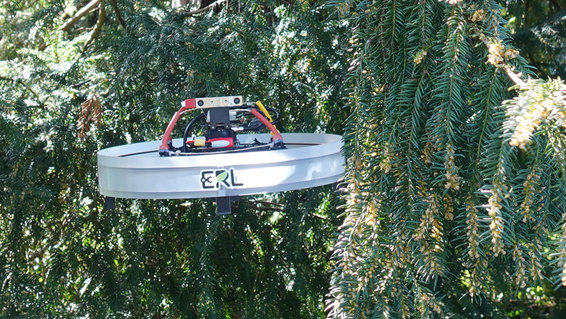03.04.2024 | Fabienne Frey | WSL News
Environmental monitoring is challenging in areas where dense vegetation limits data collection. A team of researchers from the Swiss Federal Institute for Forest, Snow and Landscape Research WSL, ETH Zürich, and University of Pisa has built a new drone that can find its way through branches, just like animals do. This is an essential step towards assessing biodiversity in remote areas.
Drones usually perceive vegetation as obstacles that should be avoided. However, valuable data for biodiversity monitoring lies within and beyond dense vegetation. This prompted researchers from the WSL, ETH Zürich, and University of Pisa to experiment with the ability of drones to navigate through branches. Taking inspiration from nature, they managed to build an aerial robot that can push away and slide through obstacles. “Our work makes an initial contribution towards monitoring currently unreachable areas”, says Emanuele Aucone, first author of the study published in Nature Communications.
Challenged by the flexibility of vegetation ¶
Environmental DNA, the genetic material in environmental samples, is of great value for biodiversity monitoring. It allows to assess all species present in one sample. Collecting the samples in the forest is more complicated than in open areas. The research team of the Environmental Robotics Lab had already collected environmental DNA with drones from isolated branches in previous studies, but they could not proceed further in the canopies. According to Aucone, the density of vegetation stopped the drone from proceeding: “Flexible obstacles like branches are especially challenging because they put oscillations on the drone when it tries to cross them. So we had to design the drone more specifically”.
Inspired by cockroaches ¶
The researchers looked at animals for inspiration. When animals move through vegetation, they can sense the interaction on their body and react flexibly. Therefore, the scientists gave the drone the possibility to sense contacts with the environment all around the body, and haptic feedback control to react to the contacts. For the design of the body, they chose a streamlined shape and low-friction material, similar to the features of cockroaches’ bodies. Experiments confirmed that these features help the drone to overcome obstacles. With a non-streamlined body or high-friction material, the drone got stuck (see video 1). Otherwise, it could push away and slide through branches with and without leaves (see video 2).
The experiments were carried out with single obstacles. The researchers’ next step is to develop a sensorized body that can detect multiple objects. “The further we move into the forest, the more obstacles our drone encounters simultaneously. To access the inside of canopies, the drone needs a full body sensing capability.” Aucone sees potential applications of such a drone beyond environmental monitoring, for example in precision agriculture or search and rescue.
Always up to date: Subscribe to the WSL Newsletter
Contact ¶
Publication ¶
Copyright ¶
WSL and SLF provide image and sound material free of charge for use in the context of press contributions in connection with this media release. The transfer of this material to image, sound and/or video databases and the sale of the material by third parties are not permitted.
